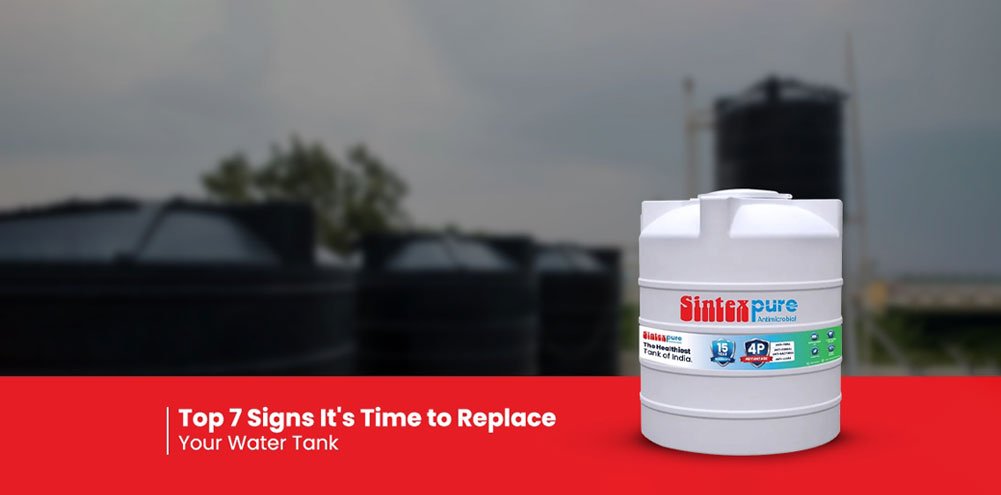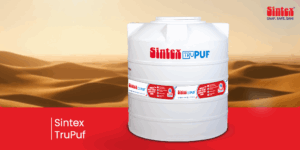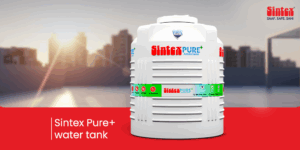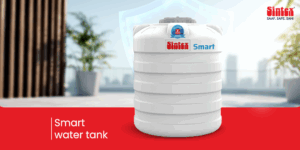Top 7 Signs It’s Time to Replace Your Water Tank
Share

Table of Contents
You go home, switch the water tap on, and expect it to turn on like in an average movie. What if the water comes out looking different, smelling strange, or worse, it begins gushing out in uncommon areas? If you have started noticing strange things about your water tank, it could be signalling something.
At Sintex, we understand and appreciate the importance of a dependable water storage tank, whether a 500-litre water tank for a small home or a 1500-litre for a bigger setup.
So, what warning signs should you look for to determine when it is time to replace the tank? Here are the top seven signs you should watch out for.
1) Rust and Corrosion
Are there any rust flakes in your water, or do you observe rusty stains outside your tank? Rust is one of the first signs that a tank is aging. The metal parts in older tanks may get damaged due to constant exposure to air and water. If you’re using a plastic tank, red flags exist in the form of rust on connected metal parts.
It weakens the structure and affects the quality of water. It is time to look for a new tank if the water is giving off a metallic smell and rusty streaks are surfacing on the surface of the water tank.
2) Leakage or Moisture
Your tank isn’t just about looks—it plays a crucial role in your Ranch home. After all, no one likes the sight of water puddles or damp, patchy corners. It is symptomatic that something is physiologically wrong with the water storage tank leak. When leaking, a water storage tank can sometimes waste eleven litres of water each day and adversely affect your walls and flooring. The leaks are occasionally petty and easily overlooked at the borders and bottom seams.
These small cracks may grow worse over time if not sealed properly. Whether it’s a compact 500-litre or a 1500-litre water tank, an average inspected tank can help stop leaks from reaching a proverbial land of no return.
3) Foul Smell or Strange Taste in Water
Water must have specific defining parameters – clear and clean with no flavouring. If the foul scent continues to exist, it is possible that your water tank is not the root cause, but certainly a root cause.
Bacteria, as well as microbes, can breed underneath water within underlying sediments. If the tank is not frequently churned and remains stagnant for long, this contamination pollutes the water and makes the tank unusable
4) Discoloration of Water
Is the water that you are using slightly yellow, brown, very cloudy, or have a bad odour? If yes, that’s not normal. Cloudy or discoloured water is usually a byproduct of internal damage or obstruction due to rust, dirt, or even mould within the tank. As the water is stagnant, it doesn’t gurgle like a boiling kettle or make any noise, glowing a warning light without the audible sign. There is always a discolouration mark when looking fine outside or in a water tank.
Whether it is a 1000-litre for domestic use or a 1500-litre water tank for industrial use, one fact is irrefutable—water is dirty, and that portion of the tank is unsafe. Where there is a compromise or mark on a surface, smarter (and safer) choices must be taken to become replacements.
5) Algae or Slime Growth
Sunlight + moisture = algae. And your tank is the perfect host.
Exposure to the sun with little insulation or a proper lid makes the tank susceptible to algae. Greenish spots and slime on the inside walls signal growth. This might look downright gross, but it can also prove dangerous.
Algae growth can affect your water’s taste and quality and cause health issues. If this happens often, your water storage tank will age beyond its prime even after cleaning.
6) Weakening of the Tank Structure
Touch the sides of your tank. Do they feel brittle, thin, or weak?
As water tanks age, especially plastic ones, they lose their structural integrity. You might notice warping, cracks, or even minor dents that weren’t there before.
A weakened structure is a ticking time bomb—it can collapse under pressure or temperature fluctuations. If your 500-litre water tank seems less sturdy than it used to be, or your 1500-litre tank shows signs of sagging, it’s safer to replace it than to wait for it to fail.
7) Outdated Capacity or Design
Are you running out of water too quickly? Or you installed your tank years ago when your usage was far lower.
A mismatch between your water needs and tank capacity is a big reason to upgrade. Modern water storage tanks also have better features—improved insulation, UV protection, and safer materials.
Final Thoughts
Your water tank operates quietly behind the scenes every single day. While you receive no alerts regarding malfunctions, the signs of trouble should not be overlooked, as they could lead to water pollution, infrastructural ruin, and costly repair bills.
So, reflect on this: do you think your water is as pure and unclouded as it should be? If you answer yes, perhaps it’s time to consider buying a new tank instead of waiting for your old one to break completely.
Sintex offers 500-litre and 1500-litre tanks, so we sell water storage tanks and tailor water storage solutions based on exact requirements.





